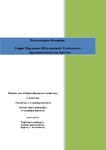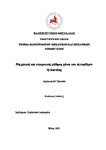Mostra i principali dati dell'item
A Distance Learning VR Technology Tool for Science Labs
| dc.creator | Paxinou E., Mitropoulos K., Tsalapatas H., Kalles D. | en |
| dc.date.accessioned | 2023-01-31T09:46:40Z | |
| dc.date.available | 2023-01-31T09:46:40Z | |
| dc.date.issued | 2022 | |
| dc.identifier | 10.1109/IISA56318.2022.9904341 | |
| dc.identifier.isbn | 9781665463904 | |
| dc.identifier.uri | http://hdl.handle.net/11615/78008 | |
| dc.description.abstract | Distance learning technology and online learning are here to stay. The pandemic crisis made that very clear but the increasing number of the students who are grown up as 'digital natives' and want to communicate and learn mostly through technology, make institutions to rethink their instructional approaches in ways that are innovative and technologically modern. It now seems quite feasible to use digital technology in order to organize a virtual classroom and teach a topic that is traditionally taught through lectures in a physical classroom. But, what about the distance teaching of a laboratory course where physical presence in the lab was, until recently, necessary and sometimes mandatory? In this work we propose a solution to this new demand. We present an educational interactive activity that uses desktop immersive virtual reality (VR) technology to familiarize students with the use of laboratory instruments, specifically of a photonic microscope. To that end we also record and analyze students' actions in an Analytics Platform. The presented VR activity is an example of how instructors in Natural and Physical Sciences can expand their options of engaging their students in the laboratory courses. This approach can also be adopted in a flipped or blended classroom, in pandemic or normal situation, to prepare students for their experiments in a stimulating, safe, low-budget and time-flexible way. Additionally, the instructors may have immediate access to valuable information on their students' engagement with the subject matter, as the learning analytics back-end offers them a clear view of the most difficult steps of an experiment, thus allowing them to improve their instructional approaches in their on-site labs. © 2022 IEEE. | en |
| dc.language.iso | en | en |
| dc.source | 13th International Conference on Information, Intelligence, Systems and Applications, IISA 2022 | en |
| dc.source.uri | https://www.scopus.com/inward/record.uri?eid=2-s2.0-85141077729&doi=10.1109%2fIISA56318.2022.9904341&partnerID=40&md5=5566a4a387634cb7b2580ba37ed1cec8 | |
| dc.subject | Budget control | en |
| dc.subject | E-learning | en |
| dc.subject | Engineering education | en |
| dc.subject | Laboratories | en |
| dc.subject | Teaching | en |
| dc.subject | Virtual reality | en |
| dc.subject | Analytic platform | en |
| dc.subject | Desktop virtual reality | en |
| dc.subject | Distance learning educations | en |
| dc.subject | Distance learning technologies | en |
| dc.subject | Distance-learning | en |
| dc.subject | Laboratory course | en |
| dc.subject | Onlab | en |
| dc.subject | Online learning | en |
| dc.subject | Technology learning | en |
| dc.subject | Virtual reality technology | en |
| dc.subject | Students | en |
| dc.subject | Institute of Electrical and Electronics Engineers Inc. | en |
| dc.title | A Distance Learning VR Technology Tool for Science Labs | en |
| dc.type | conferenceItem | en |
Files in questo item
| Files | Dimensione | Formato | Mostra |
|---|---|---|---|
|
Nessun files in questo item. |
|||

